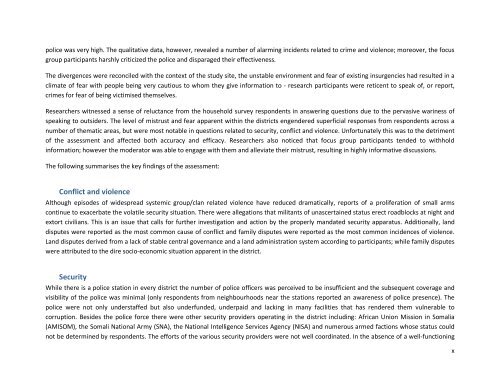Eastern Zone DCSA
Eastern Zone DCSA
Eastern Zone DCSA
Create successful ePaper yourself
Turn your PDF publications into a flip-book with our unique Google optimized e-Paper software.
police was very high. The qualitative data, however, revealed a number of alarming incidents related to crime and violence; moreover, the focus<br />
group participants harshly criticized the police and disparaged their effectiveness.<br />
The divergences were reconciled with the context of the study site, the unstable environment and fear of existing insurgencies had resulted in a<br />
climate of fear with people being very cautious to whom they give information to - research participants were reticent to speak of, or report,<br />
crimes for fear of being victimised themselves.<br />
Researchers witnessed a sense of reluctance from the household survey respondents in answering questions due to the pervasive wariness of<br />
speaking to outsiders. The level of mistrust and fear apparent within the districts engendered superficial responses from respondents across a<br />
number of thematic areas, but were most notable in questions related to security, conflict and violence. Unfortunately this was to the detriment<br />
of the assessment and affected both accuracy and efficacy. Researchers also noticed that focus group participants tended to withhold<br />
information; however the moderator was able to engage with them and alleviate their mistrust, resulting in highly informative discussions.<br />
The following summarises the key findings of the assessment:<br />
Conflict and violence<br />
Although episodes of widespread systemic group/clan related violence have reduced dramatically, reports of a proliferation of small arms<br />
continue to exacerbate the volatile security situation. There were allegations that militants of unascertained status erect roadblocks at night and<br />
extort civilians. This is an issue that calls for further investigation and action by the properly mandated security apparatus. Additionally, land<br />
disputes were reported as the most common cause of conflict and family disputes were reported as the most common incidences of violence.<br />
Land disputes derived from a lack of stable central governance and a land administration system according to participants; while family disputes<br />
were attributed to the dire socio-economic situation apparent in the district.<br />
Security<br />
While there is a police station in every district the number of police officers was perceived to be insufficient and the subsequent coverage and<br />
visibility of the police was minimal (only respondents from neighbourhoods near the stations reported an awareness of police presence). The<br />
police were not only understaffed but also underfunded, underpaid and lacking in many facilities that has rendered them vulnerable to<br />
corruption. Besides the police force there were other security providers operating in the district including: African Union Mission in Somalia<br />
(AMISOM), the Somali National Army (SNA), the National Intelligence Services Agency (NISA) and numerous armed factions whose status could<br />
not be determined by respondents. The efforts of the various security providers were not well coordinated. In the absence of a well-functioning<br />
x


